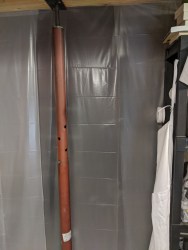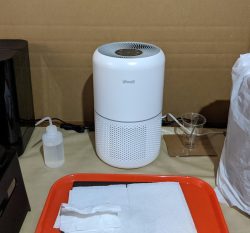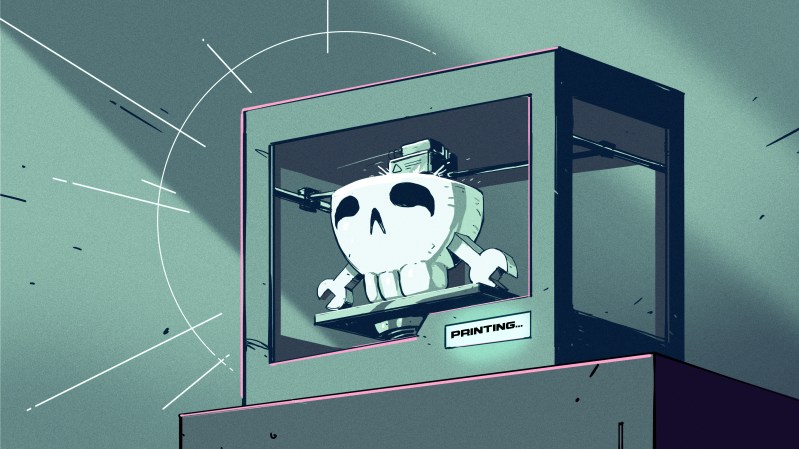Nowadays, resin printers are highly accessible and can do some great stuff. But between isopropyl alcohol for part rinsing and the fact that some resins have a definite smell to them, ventilation can get important fast. The manufacturers don’t talk much about this part of the resin printing experience, but it’s there nevertheless. So what can be done when smells become a problem?
I recently had to deal with this when I printed several liters of resin worth of parts. That’s a lot of resin, and a lot of alcohol for part washing. Smells — which had never been much of a problem in my work area — suddenly became an issue.
Where Odors Come From
Smells come from two sources: the resin itself, and the isopropyl alcohol used for cleanup and part washing.
Most Resins Have a Smell

It’s an odor I describe as “raw plastic, with solvent undertones” and some are worse than others.
The variety of resins in my workshop doesn’t even come close to representing everything on the market, but I have given the sniff test to the ones I have on hand. The Elegoo brand resins (White, Translucent, and Grey) all have a distinct odor, with their Black resin smelling strongest overall. Monocure Flex100 resin definitely smells, and ApplyLabwork Modeling resin (advertised as being compatible with Formlabs printers) also clearly smells.
In my experience Formlabs standard resins (white, grey, and clear in particular) are standouts in that they have no particular odor to them, but Formlabs Durable does, and [Bunnie Huang] also noted that the Formlabs Draft resin had a very strong smell to it during his Form 3 teardown. There are many more out there.
Alcohol Loves Evaporation
Isopropyl alcohol is the usual choice for rinsing uncured resin from finished prints during post-processing, and alcohol also happens to rapidly evaporate at normal room temperature. This makes it easy to dry off finished prints, but it also means alcohol jumps at the chance to fill a work area with fumes.
Quantity Can Tip the Scales
What isn’t a problem as a small job may cross the line once quantities go up. Opening and pouring smelly resins, having them sit in an build tank, and the print process itself (which agitates the resin) all contribute to smelling up the immediate area. A small print job might be dealt with by taking a break and airing out the work area, but extended printing means those smells just keep coming.
With alcohol, the more drying and pouring and agitating is going on, the more evaporation and therefore the more smelly the area becomes. For larger jobs, automatic part washing starts to look attractive but there is a side effect. Machines like Formlabs’ Form Wash, Prusa’s CW1, and Anycubic’s upcoming Wash & Cure Machine all aim to make part washing more controlled and convenient, but they do not eliminate odors. Not only are these units not airtight while in use, but the agitation and part drying involves more evaporation than doing small jobs by hand, which is more easily done with sealed containers.
Ways to Deal With Odors

When I started a large and extended print job, frequent part washing combined with extended print times led to resin and alcohol smells dominating my work area. Odors were never an issue before, but It was clear I had to make some changes. Here are some options for doing smell control:
- Crack a window, or banish printing related stuff to somewhere like a garage. A simple and obvious solution, but not always an option.
- Add a fan and ducting to send the exhaust somewhere inoffensive. There is also the option to add an activated carbon filter into the mix. Amazon has plenty of combos and options for inline fans for this kind of ventilation, usually aimed at hydroponics or other indoor plant growers. If you go this route I suggest getting a speed control for the fan, otherwise you’ll be stuck at full speed (and full volume.)
-

Dollar Store frosted plastic table covers are effective at closing off an area. Cover a part washer in a plastic bag when not in active use. If a part washing machine isn’t sealed, it’s always allowing some amount of alcohol to evaporate unless it’s empty. If the part washer is on standby (not being actively used but also not ready for storage) I found that covering it with a small plastic garbage bag between uses reduced the amount of alcohol smell that it gave off.
- Hang plastic sheets to close off the printing area. I found that sectioning off a part of the room with plastic sheeting was remarkably effective at containing smells. It doesn’t eliminate them, but it makes them much more controllable. Cardboard, a staple gun, Dollar Store frosted plastic table covers, and an unfinished ceiling are friends in this venture. Cut the plastic just above floor level, and overlap the seams to provide a curtained way in and out.
- Filter the enclosed area with an air purifier. This will recirculate the air, filtering it to remove smells in the process. I found this to be extremely effective when combined with curtaining the print area off with plastic sheets. Make sure the filter has an activated carbon (also called activated charcoal) component to it. A term that may show up when shopping for filters is whether it handles VOCs, or volatile organic compounds. The air purifier I bought also had a timer function, which came in unexpectedly handy for intermittent use. Kijiji or craigslist is a good source for second hand air purifiers.
-

Air purifier inside print area. Wear a mask with VOC filter when working directly with smelly materials, such as filling or emptying an automatic part washer. All that alcohol pouring puts a lot of fumes into the air, and while a mask won’t change that, it will make the hands-on part of the job a more pleasant one. The mask I use is an inexpensive 3M half-face mask, for which the VOC filters are standardized and don’t cost much. If possible it’s best to just do this job outside, but If pouring around a bunch of alcohol must be done indoors in the work area, wear the mask while doing it and let the air filter or fan take care of the rest.
If smells are a problem for you, one or more of these should help get you back in control over your work area.
Keeping Your Nose Happy
Getting surprised by smells can happen, and if it does, there are tools that can be used to mitigate it and keep the work area livable. Are there better options for extracting or otherwise handling smells or fumes? What have you done to handle them yourself? Know of any particularly nasty (or friendly) resins? Chime in with the comment section to let us know.
As a final note, there are now some newer resins advertised as water-washable, which sounds promising. Do you have experience with them? Do they smell less, or not at all? We’d love to hear from you in the comments.















Firstly, I think a lot of people would like to know of an alternative to IPA as it may be in short supply for months.
Secondly, where weed has been legalised, grow tents with VOC filtering blowers are becoming a commodity item for home grown. These seem to me like a good candidate for repurposing.
I use acetone to wash out the resin, it seems to be a stronger solvent, so the parts must not be in it for too long.
For air purification, i just used a car filter with EPA and Active Carbon, with a fan sucking air into it. Works great, and car filters are dirty cheap.
Maybe try Ethanol. Comes in 95% depending on Country/State/County under brand names like Everclear, typically it’s purity is high enough to be considered more-or-less “Food Safe” for non-pregnant adults of a certain age depending on legal jurisdiction; though if you’re drinking this particular formulation i’d question your taste buds. Anyways it’s a fairly safe solvent whose properties are very close to that of IPA and may be more readily available for some.
Denatured alcohol
Some manufacturers now produce a water-washable resin. No IPA required.
“Firstly, I think a lot of people would like to know of an alternative to IPA…”
Lager, witbier, ale, stout, etc.
(c:
Methanol / wood alcohol / methyl hydrate / hydroxymethane / gas line antifreeze is a pretty good universal replacement. Cheaper and a bit more benign to plastics than acetone. 2-3x more toxic than ethanol or acetone: do not drink. Greater fire hazard than either too.
“Mean Green”. It’s cheap (less than $5/qt at Home Depot), and has the same basic constituents as that ResinOff stuff. Doesn’t make prints foggy, doesn’t smell. I use it exclusively (which allowed me to use the gallons of 99% isopropanol I collected for more pressing matters).
Any alternative to this brand in Europe?
Since recently, Formlabs recommends Tripropylene Glycol Monomethyl Ether (TPM)
https://support.formlabs.com/s/article/Choosing-the-right-wash-solvent
Haven’t tried it though, no idea if it works with other resin brands.
70% Isopropyl Alcohol (IPA) – 55 Gallon Drum $1,221.00. Out of stock.
https://ecolink.com/shop/solvents/wipe-solvent/70-isopropyl-alcohol-ipa-55-gallon-drum/
If memory serves that’s like five or ten times the usual price. Pandemic effect.
Our Formlabs printer no longer works after multiple firmware update appeared to have bricked it. Be careful with any company where you are the guinea pig for a start up. Never again.
Oh, that? Did the update coincide with the release of the 3?
Joking aside, the F1 is pretty open now, isn’t it?
http://form1printer.pbworks.com/w/page/74138198/Firmware%20Update%20in%20DFU%20Mode
I’d think it more likely something let out the magic smoke over unrecoverable fireware breakages. I’ve had that on printers before the seemingly co-incendental timing I’ve always put down to a change that pushes something harder than its heat/age can take (but probably well in spec) or flexing of parts having moved it to update.
No experience with Formlabs gear though I’ve had my eye on their stuff for a while though.
My printers are all enclosed, and connected (along with solder fume extractor) to a manifold and one common extractor fan, like a central vacuum system but much quieter. Each port has a rotary (ball) valve and on switch, like a shop dust extractor. It exhausts outside, and even though it moves only around a 50 cubic meters per hour it has made a huge difference to the livability of the space.
I would not have guessed it would have made much of a change, but like the article said: once you hit a certain quantity it’s a tipping point. It was a pain in the butt to install, but well worth it.
“Amazon has plenty of combos and options for inline fans for this kind of ventilation, usually aimed at hydroponics or other indoor plant growers.”
*hint* *hint* *wink* *wink*
With all that being said, do these chemical vapors present a fire or explosives hazard?
In the right fuel air ratios, as does corn starch, hairspray or nail polish remover. I think you’d need to be heating it to drive off enough vapor to be worrisome… unless you work in an unventlated closet.
So much talk about smells, no acknowledgement that these fumes are pretty toxic? Hm.
These fumes can be quite toxic over time. All hydrocarbons have their problems. Methyl and Ethyl have been proven to cause damage on the central nervous system….yeah, that one! It is a problem that can appear from repeated exposure over longer periods of time. And of course, it’s a crap shoot if it’s gonna be you or not. Chronic pain, or types of neuropathy or stroke or heart issues, type one diabetes can be a product of hydrocarbon exposure, too. How the toxicity expresses itself is often the genetic weakness in your family. It just wears on you over time. If you’re getting dizzy or headaches from a short exposure your body is telling you this stuff hurts us. Over time it’s hurting you more!
But, hey! Any art student worth their chops has read the literature on the toxicity of the materials they work with. Do your best to acknowledge these issues READ and create the safest work environment that you can. It’s still fun! C’mon, Even sex can kill you. Protect yourself and you won’t be bitter later.
I have recently started resin printing, I have an extractor fan moving air to the outside, I use nitrile gloves, voc mask and do whatever I have to do to keep safe as I suffer from allergies. however whilst cleaning outside with ipa I splashed a small amount on my wrist and only cleaned it once I had finished. down the line I have had really bad rash on my forearms as the allergic reaction slowly kicked in. just a warning, no exposed skin anywhere near the resin and ipa/water mix. I still suffer badly even though I am using steroids